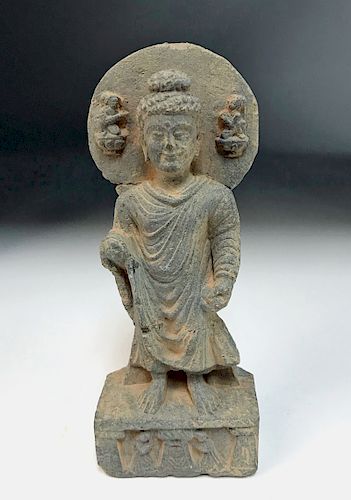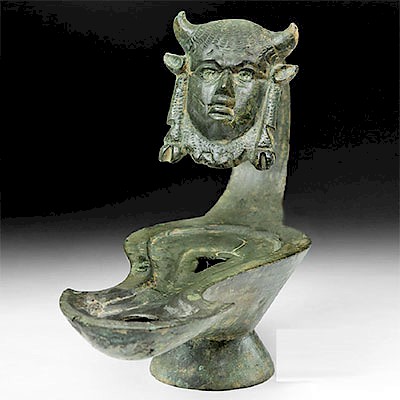Gandharan Schist Figure - Standing Buddha
Lot 105
About Seller
Artemis Gallery
686 S Taylor Ave, Ste 106
Louisville, CO 80027
United States
Selling antiquities, ancient and ethnographic art online since 1993, Artemis Gallery specializes in Classical Antiquities (Egyptian, Greek, Roman, Near Eastern), Asian, Pre-Columbian, African / Tribal / Oceanographic art. Our extensive inventory includes pottery, stone, metal, wood, glass and textil...Read more
Estimate:
$800 - $1,200
Absentee vs Live bid
Two ways to bid:
- Leave a max absentee bid and the platform will bid on your behalf up to your maximum bid during the live auction.
- Bid live during the auction and your bids will be submitted real-time to the auctioneer.
Bid Increments
| Price | Bid Increment |
|---|---|
| $0 | $25 |
| $300 | $50 |
| $1,000 | $100 |
| $2,000 | $250 |
| $5,000 | $500 |
| $10,000 | $1,000 |
| $20,000 | $2,500 |
| $50,000 | $5,000 |
| $100,000 | $10,000 |
| $200,000 | $20,000 |
About Auction
By Artemis Gallery
Sep 27, 2018
Set Reminder
2018-09-27 10:00:00
2018-09-27 10:00:00
America/New_York
Bidsquare
Bidsquare : Antiquities | Asian | Ethnographic
https://www.bidsquare.com/auctions/artemis-gallery/antiquities-asian-ethnographic-3469
Featuring classical antiquities, ancient and ethnographic art from cultures encompassing the globe. Artemis Gallery info@artemisgallery.com
Featuring classical antiquities, ancient and ethnographic art from cultures encompassing the globe. Artemis Gallery info@artemisgallery.com
- Lot Description
Central Asia, Pakistan, India, and Afghanistan, Gandharan Empire, ca. 2nd to 3rd century CE. A large carving of a standing Buddha, hand-carved from a grey schist. The draping of his clothing is particularly finely carved with folds flowing over his neck, wrists, and down to his ankles. His meditative face is defined by almond-shaped eyes, a slender nose, and a slightly smiling mouth, all beneath a curly coiffure with a bun-shaped topknot. The Buddha stands in front of a discoid halo with a kneeling attendant on either side of his head. Another pair of figures are shown within the integral platform kneeling before a large offering bowl. Buddha's lower body and areas of the carved platform figures boast subtle areas of red-orange pigmentation. A beautiful example from ancient Central Asia! Size: 2.625" W x 6.5" H (6.7 cm x 16.5 cm).
The Gandharan Empire made itself wealthy in part by controlling lucrative trade along the mountain passes between China in the East and the Near East and Mediterranean in the West; a great deal of this wealth went into local patronage of artisans and art. In the first century CE, Buddhism became fashionable amongst Gandharan elites, and the art produced at this time depicting the Buddha are some of the most striking Buddhist images from the past. Their artistic tradition also reflects the conquest of Alexander the Great and the introduction of styles from all sides, blended into a uniquely Gandharan tradition, which this Buddha exemplifies.
Provenance: private East Coast, USA collection
All items legal to buy/sell under U.S. Statute covering cultural patrimony Code 2600, CHAPTER 14, and are guaranteed to be as described or your money back.
A Certificate of Authenticity will accompany all winning bids.
We ship worldwide and handle all shipping in-house for your convenience.
#137357Repairs to discoid halo and midsection of body with small chips and light adhesive residue and earthen stabilization material along break lines. Surface wear and abrasions commensurate with age, loss to one hand and small area of verso, fading to some carved designs, and chips along base, body, arms, head, and halo. Nice earthen deposits throughout, and remnants of original red-orange pigment on lower body and platform.Condition
- Shipping Info
-
All shipping is handled in-house for your convenience. Your invoice from Artemis Gallery will include shipping calculation instructions. If in doubt, please inquire BEFORE bidding for estimated shipping costs for individual items.
-
- Buyer's Premium



 EUR
EUR CAD
CAD AUD
AUD GBP
GBP MXN
MXN HKD
HKD CNY
CNY MYR
MYR SEK
SEK SGD
SGD CHF
CHF THB
THB















